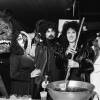Halloween traditions — trick-or-treating, eating sweets, carving pumpkins and connecting with the paranormal and the spooky — were built by New Englanders, from devil-wary Puritans to immigrants who brought their own deities and traditions to the holiday.
“Some of the research that I found was incredible and fascinating,” said Anthony Sammarco, a local historian and author of the book " Halloween Traditions in Boston, " on Morning Edition. “And it was a joy to write because not only do I have very illuminated and beautiful photographs in color, but you begin to see in some ways that it was being celebrated by Bostonians of all walks of life.”
More Local News
Sammarco said some of the darkest parts of the region's Halloween history, involving accusations of witchcraft and trials and executions , were rooted in the Puritan belief in the devil. But a little more than a hundred years later, with the arrival of new immigrants in Massachusetts, some of our more familiar Halloween traditions began to form.
The holiday as it’s celebrated in New England today is a descendant of Samhain, an ancient Celtic end-of-harvest festival, Sammarco said.
“By the 19th century, many of the people that began the aspect of immigration in Boston were Irish in the 1840s and 1850s, and these people were bringing Celtic traditions,” Sammarco said. “And I'm not just saying Ireland, but all of the British Isles as well as Ireland.”
That included Samhain, but also the Morrígan, an ancient deity depicted walking with crows; and a con man known as Stingy Jack, the eventual inspiration for jack-o’-lanterns.
Stingy Jack “was banned from both heaven and hell,” Sammarco said. He was “given a hollowed-out turnip with a piece of coal from hell to light his eternal wandering of the earth. And that Stingy Jack became our jack-o’-lantern.”
That shift from turnips to pumpkins, from Stingy Jack to jack-o’-lantern, marks just one of a series of Halloween transformations in Boston.
“A jack-o’-lantern was much easier to carve than a turnip. And in that way, by hollowing it out and placing a candle within, it's still a descendant or a reinterpretation — because the pumpkin was so easy to carve — of that ancient ritual,” he said.
"It [Halloween] was being celebrated by Bostonians of all walks of life."-Anthony Sammarco, historian
By the 1920s and 1930s, Halloween often involved the All Hallows Eve motifs of witches, ghosts and skeletons, he said. It also involved the concept of trick-or-treating.
“Tricks or treats meant that if one didn't give soul cakes in the 19th century, which was a sweet cake, you had tricks, which might be the fact that your fence was destroyed, your house was egged, your property would be destroyed on the grounds,” he said. “And children as well as adults would actually create the sense of what was really trick or treating.”
Sammarco said it was interesting to see how different cultures came together to shape the holiday in Boston.
“I think it's kind of fun to have people look at this as another one of the holidays that Bostonians share,” he said. “And though it has direct connections to the ancient Celts, today, in the 21st century, Bostonians come from a wide spectrum. It's a thriving nexus of cultures that everyone has their own interpretation. But in some ways, those interpretations are shared.”









